Ardèche: A World of Picture-Perfect Wonders
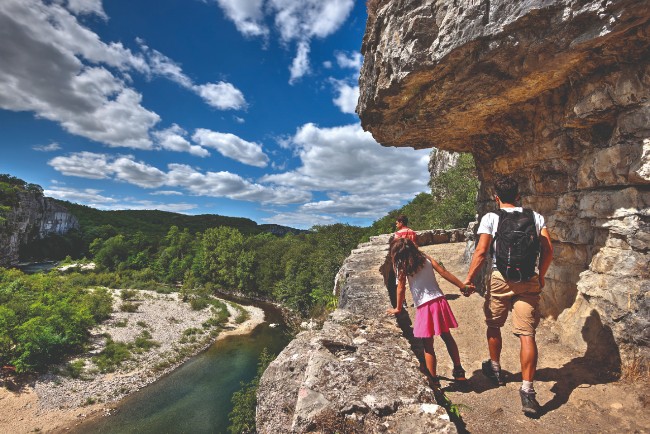
The landscape of this rugged region has inspired humankind since prehistoric times. Gillian Thornton meanders amongst works of art both man-made and natural…
As warm welcomes go, our reception at Mazan-l’Abbaye is positively scorching. This ruined Cistercian abbey nestles in a deep valley on the western fringes of Ardèche, but at first it seems that my husband and I are about to miss out: the narrow road above the ancient buildings is lined with vehicles. We pull the car over in the hope of snatching a quick look – and that’s when we hear the drums.
As we look down, a procession appears through a gap in the 12th century masonry, drummers at the front, a train of people behind. What for? Well, suffice it to say, it isn’t just for us. But then interesting things clearly happen at Mazan-l’Abbaye, which stands close to the Watershed line slicing north-south through the Ardèche mountains.
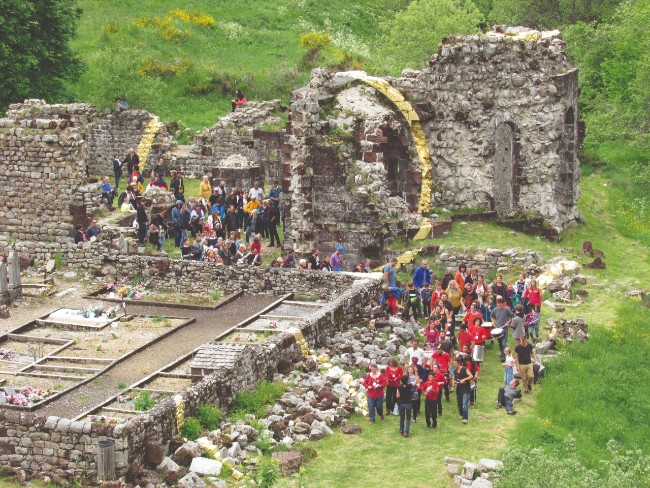
The drummers approach at Mazan- l’Abbaye. Photo: Gillian Thornton
NATURAL INSPIRATION
A natural quirk of the landscape, the invisible Ligne de Partage des Eaux determines the destination of rainwater landing on the rocky slopes. Rain falling on one side will end up in the Atlantic; rain falling the other way in the Mediterranean. So what better excuse for an artistic trail in a département where Nature has inspired Man across millennia?
I’ve long had a soft spot for Ardèche, one of France’s least populated départements and now part of the Auvergne-Rhône-Alpes super-region. Located at the northern gateway to Provence, it takes its name from the river that winds across the southern fringes of the département to join the Rhône north of Avignon.
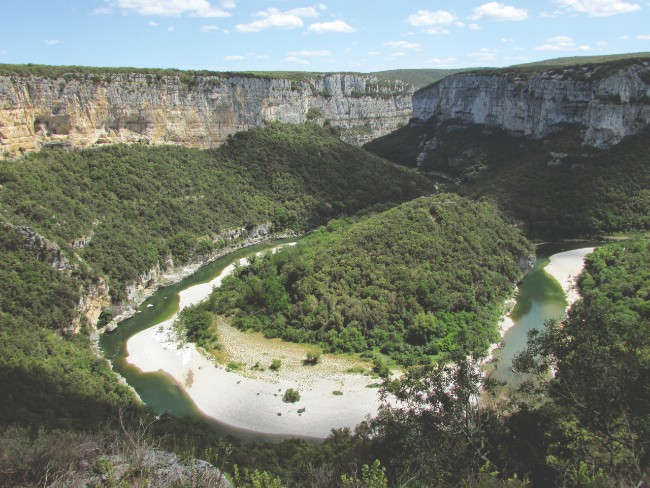
The Ardèche Gorge. Photo: Gillian Thornton
On its eastern flank, Ardèche cosies up against the Rhône for 135km heading north to Lyon. Head west, however, and it becomes increasingly mountainous. Classified by UNESCO as a Global Geopark, the Monts d’Ardèche Regional Nature Park is an area of dramatic volcanic scenery and huge vistas.
With its combination of medieval villages and market towns, its river scenery and underground caverns, Ardèche will enchant anyone who loves an authentic country lifestyle coupled with outdoor activities that range from biking and hiking to canoeing and climbing. But Ardèche is also an area where Art and Nature sit harmoniously together, not just in Nature’s own handiwork, but in the way that artists of all kinds have worked with the landscape across the centuries.
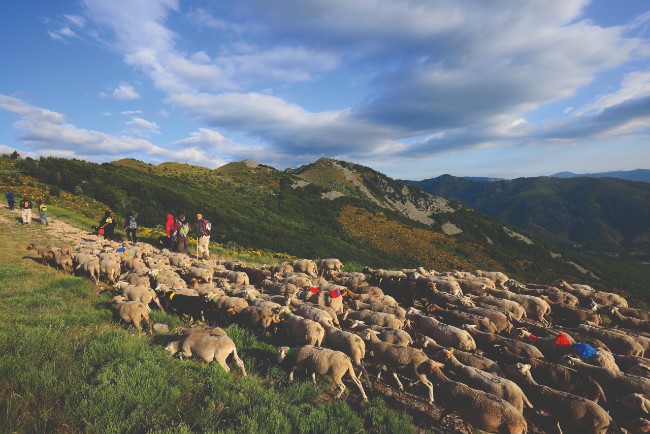
The seasonal movement of animals on the Tanargue. Photo: M Dupont
Along the Watershed, for instance, six outdoor artworks have been commissioned from contemporary designers, such as Felice Varini, creator of Un Cercle et Mille Fragments here at Mazan. Arcs of gold leaf adorn the roof and walls of the abbey as well as the bridge and fortifications. Stand in the right spot and, I’m reliably told, you can see one complete circle surrounded by fragments of circles at regular intervals.

You can enjoy breathtaking views on a train journey through the Vallée du Doux. Photo: M Rissoan
Stretching for almost 100km through Ardèche, the Watershed Trail can be explored on two or four wheels, or two or four legs, and whichever mode of transport you choose, you’re guaranteed a spectacular north-south ride. Pass beneath Mont Mézenc, the highest mountain in the Monts d’Ardèche Nature Park; the source of the Loire at Mont Gerbier de Jonc; and a wealth of volcanic features that seem to have come straight from a school textbook.
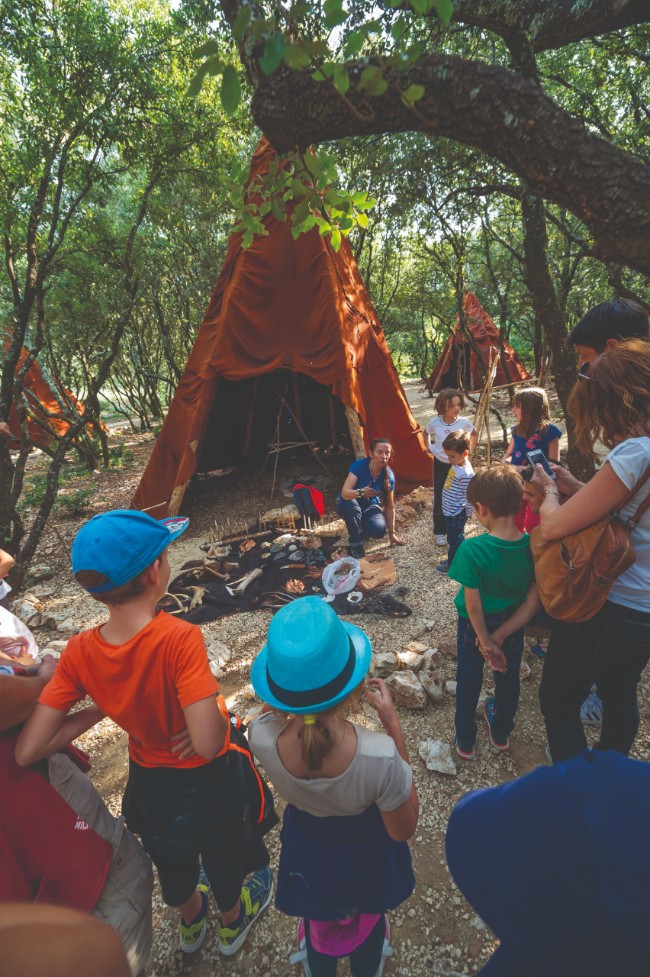
A reconstruction of
a Paleolithic camp at the Pont d’Arc cavern. Photo: Franck Charton/ Caverne du Pont d’Arc
HEAD FOR THE HILLS
But we’re heading east, arriving from the direction of Clermont-Ferrand in Auvergne and spending our first night at the Quinte et Sens chambre d’hôtes, high in the hills above the village of Barnas. Drivers must navigate a winding narrow road to the perched property at Lafarre but the tranquillity is worth it as you look down over tree-covered hills to a soundtrack of birdsong. It is the epitome of Ardèche ambiance. Here Patrick and Magali lead an environmentally-friendly lifestyle in a traditional mountain property restored with local materials. Guests can share the experience through a variety of short courses in wellbeing, detox and outdoor activities ranging from wild mushroom foraging to dog sledding.
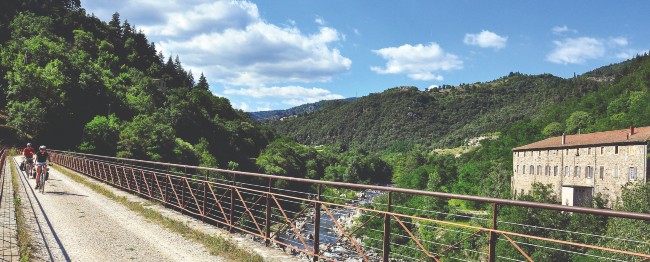
La Dolce Via cycling route is a great way to explore the area’s stunning scenery. Photo: A Renaud
However you choose to travel, this corner of the Monts d’Ardèche is packed with picturesque photo stops where you can unleash your creativity with a camera or smartphone. Explore a cluster of villages labelled ‘Villages de Caractère d’Ardèche’, which include Thueyts, where narrow streets are lined with medieval houses; Meyras, with its feudal castle and painted walls; and Jaujac, built around a shady village square.
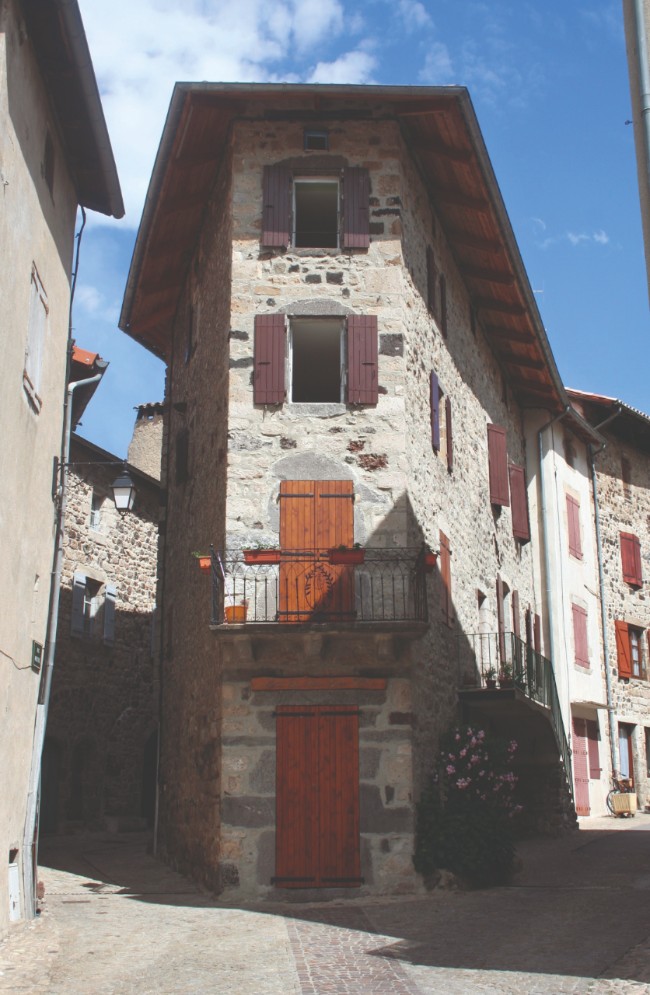
Renaissance houses in Thueyts. Photo: Gillian Thornton
Stand on the belvedere above the Romanesque bridge at Thueyts for a bird’s-eye photo of the Pont du Diable, painstakingly built with local basalt rocks, and then line up for a shot from river level. At Jaujac, take the path beside the Lignon river to see volcanic lava flow like petrified waterfalls and snap a reflective picture by the contemporary basalt ball. And don’t miss La Coulée Vive, a 90-minute discovery trail that is open all year and free to access from the Maison du Parc. Add on half an hour to reach the top of the Volcan de Jaujac for panoramic views.
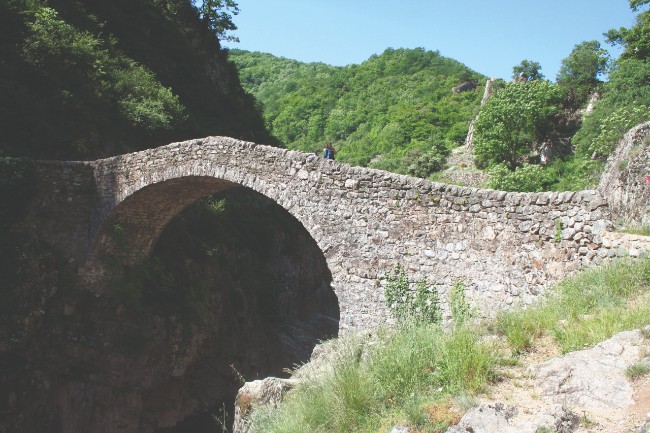
The Pont du Diable at Thueyts. Photo: Gillian Thornton
Life in southern Ardèche is predominantly rural, but the spa town of Vals-les-Bains – population less than 4,000 – offers a buzzing spa centre, casino and leisure facilities, whilst nearby Aubenas boasts around 12,000 residents. Between the two, we drop in at Mercurart, the catchy name for a private botanical garden and outdoor gallery in the village of Mercuer.
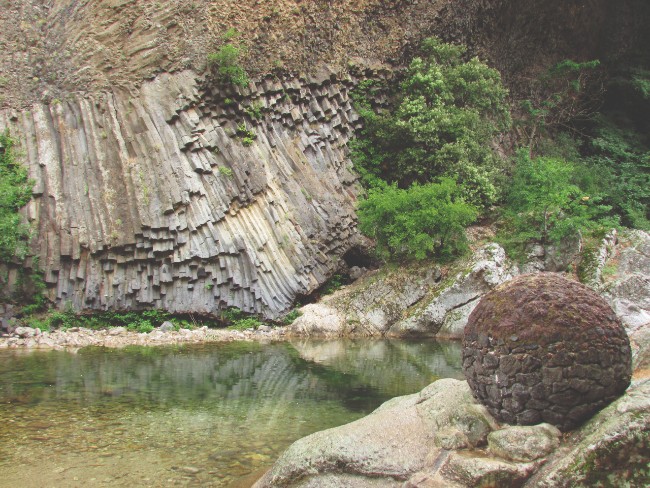
The basalt ball by the Lignon river at Thueyts. Photo: Gillian Thornton
GARDEN ART
The brainchild of business entrepreneur Jean-Claude Millet, Mercurart has been created on two hectares of terraced hillside, with more than 2,000 metres of new dry stonewall to complement ancient walls and water courses. Today this extraordinary garden combines unusual plants, many of them local, with mixed media sculptures by local artists.
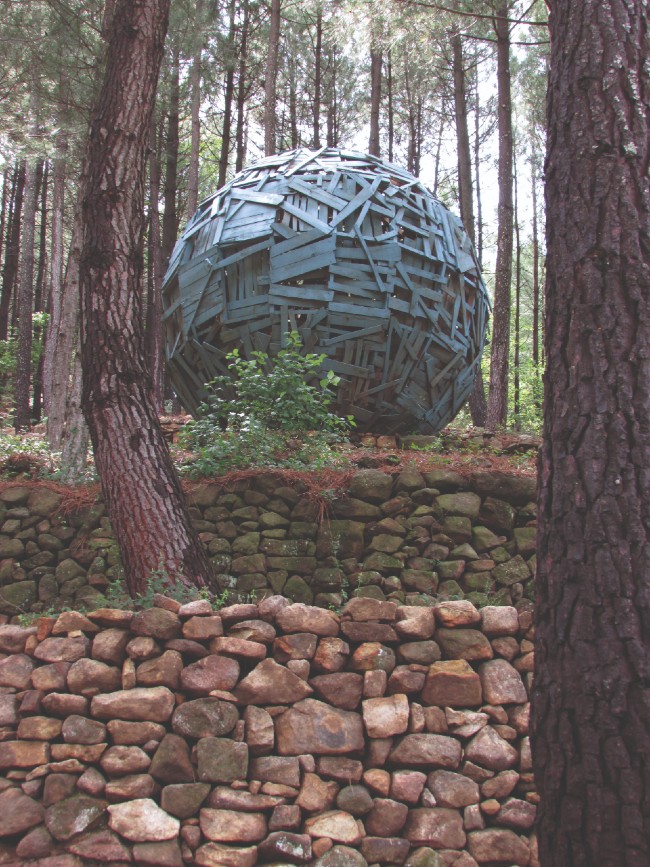
The unique sculptures at Mercurart. Photo: Gillian Thornton
Tours in English and French, guided by Jean-Claude or his plantsman, include the indoor gallery and forge, and must be pre-booked. Expect 60 varieties of scented roses, ancient varieties of vines, flowering shrubs, and herbs, all introduced with passion for both the place and the plants.
From Mercuer, it is just a few kilometres to the Domaine du Fayet just outside Sanilhac, a guesthouse labelled ‘Séjours de Charme en Ardèche’, where genial young hosts Pascal and Fanny offer five gîtes and one huge B&B room at their historic stone property, plus optional dinner for in-house guests.
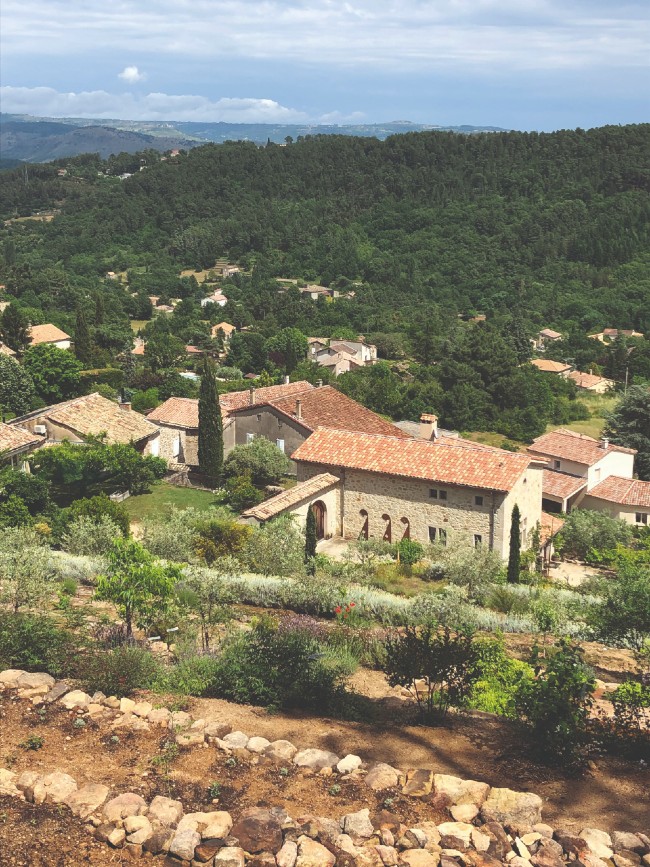
The view from the terraces at Mercurart. Photo: Gillian Thornton
Modern comforts combine seamlessly with natural materials – a bedside table fashioned from a tree trunk, a workbench turned into a handy dressing table, and a niche transformed with recycled cupboard doors.
The next day we bypass nearby Largentière, which is bustling with market shoppers on Saturday morning, in favour of another special garden deep in a wooded valley. La Roseraie de Berty is only open in the rose season, a dramatic change of lifestyle for former actress Eléonore Cruse who came here in 1971 to breed goats but swapped to roses in 1984.
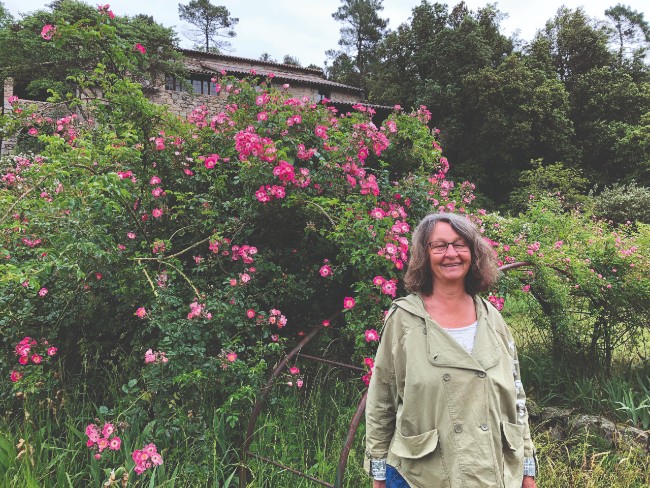
The stunning Roseraie de Berty was lovingly created by former actress Eléonore Cruse. Photo: Gillian Thornton
From small beginnings, she has become a widely respected rose expert and now grows more than 900 varieties in this enchanted spot, accessible via a winding lane where asphalt gives way to gravel. Even on a damp June morning, the scent washes over us in clouds, the roses tumbling from pergolas above secluded benches, all to a soundtrack of woodpeckers and amorous frogs. It’s a true hidden gem.
Eléonore has also created a second garden, La Roseraie des Pommiers, at Ruoms, where roses mix with flowering shrubs in a natural-style planting beside a restaurant run by her son. Ruoms stands on the Ardèche, south of Aubenas where the river leaves the Monts d’Ardèche to shimmy past the medieval villages of Balazuc and Vogüé. Wander their medieval alleyways to find artists, jewellery makers and wood carvers inspired by local materials.
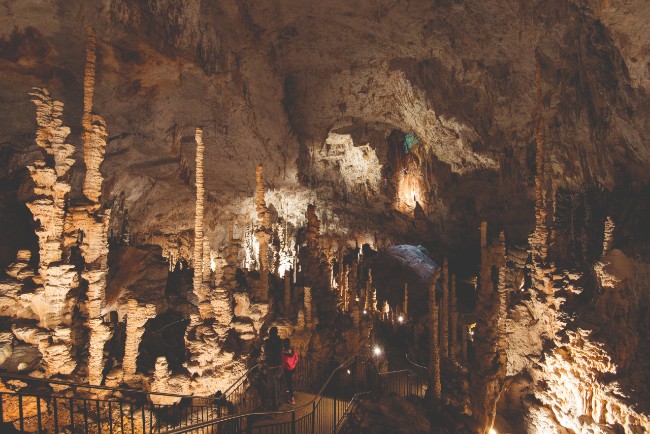
The Aven d’Orgnac cave is one of the most visited attractions in Ardèche. Photo: M Dupont
GOING UNDERGROUND
Just south of Ruoms, the river makes a sharp turn to the east towards Vallon-Pont-d’Arc and the picturesque Ardèche Gorges, beloved of kayakers of all ages and abilities. The natural rock arch of the Pont d’Arc is symbolic of Ardèche but there are stunning viewpoints with handy parking facilities along 20 miles of dramatic meanders and sheer cliffs, so take your time and charge up your camera.
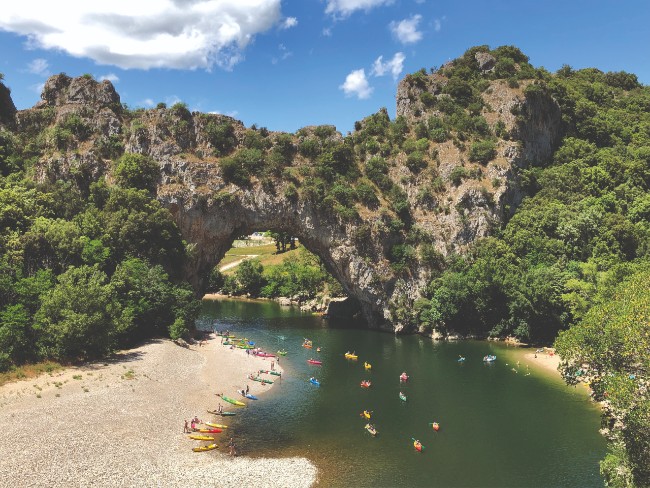
The Pont d’Arc natural stone bridge. Photo: Gillian Thornton
But make sure to leave half a day to explore a unique site that demonstrates how even the earliest humans were influenced by the natural environment of Ardèche.
Deep beneath the surface of the limestone, the Grotte Chauvet was discovered in 1994 by three cavers, its walls adorned with 1,000 animal paintings and engravings dating back 36,000 years. Listed by UNESCO as a World Heritage Site in 2014, this cultural gem is too fragile to open to the public, but a replica cave was inaugurated in 2015. Originally called the Pont d’Arc Cavern and now renamed Chauvet 2, it is perfect in every spine-tingling detail.

Chauvet 2 replicates the stunning artwork of Grotte Chauvet and is perfect in every detail. Photo: © SYCPA-SÉBASTIEN GAYET
The limestone plateau around the Ardèche Gorges is rich in underground caves, including the Aven d’Orgnac south of the river, a natural masterpiece full of glistening concretions.
But it’s hard to beat our underground experience in the Grotte de Saint-Marcel, where Jézabel Janvre from the local winemakers’ association proves all the benefits of wine tasting in a sterile and atmospheric environment. The cave alone is impressive and worth a visit at any time, but this initiation into local wines – including the aptly-named Vinolithic – with no outside odours to dull the senses is a must for confirmed oenophiles. And that evening, we enjoy another taste of Vinolithic, this time over an al fresco dinner with its producer, seventh-generation winemaker Raphaël Pommier, and his American wife, Rachel.
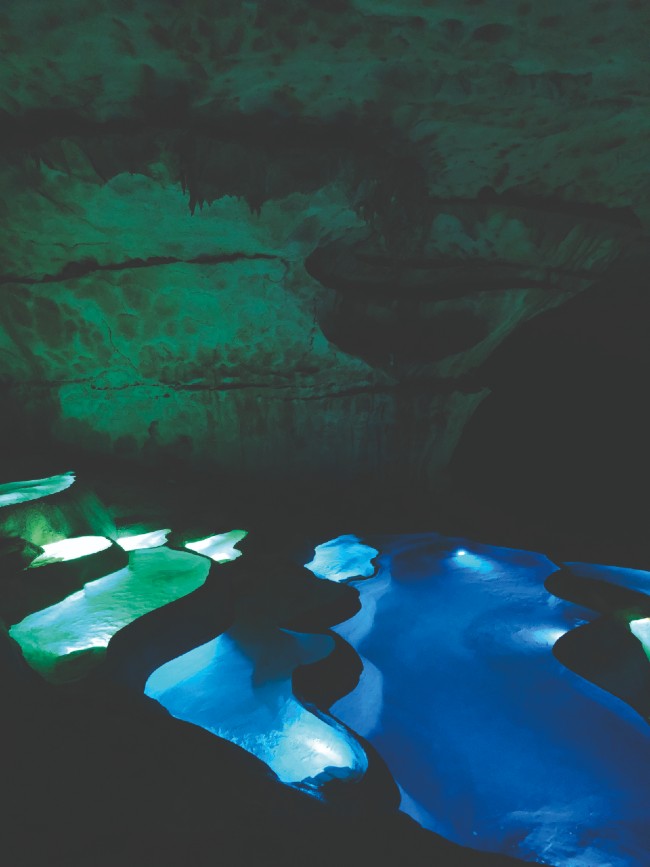
A light show illuminates the Grotte de Saint-Marcel d’Ardèche. Photo: Gillian Thornton
Just west of the Rhône Valley near Bourg-Saint-Andéol, their Domaine Notre-Dame de Cousignac is at the forefront of local wine tourism, offering B&B accommodation, hosting private functions, and running an on-site bistro, La Table du Vigneron, using seasonal produce. Oh, and did I mention they also find time to produce a full range of excellent organic Côtes du Rhône wines?
As with everyone we meet in Ardèche, the Pommiers are passionate about their area, inspired by their landscape and lifestyle and they are keen to share it with visitors – a philosophy I’m more than happy to drink to!
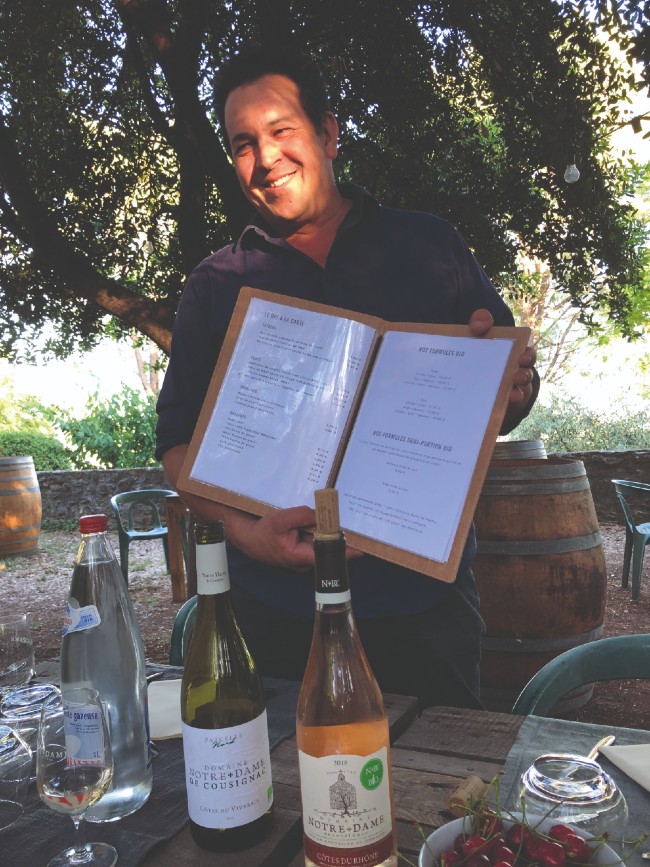
Winemaker Raphaël Pommier. Photo: Gillian Thornton
SIDEBAR: PREHISTORY COMES TO LIFE
Standing in front of a frieze of horses’ heads, I forget for a moment that these images are 36,000 years old. Each beautifully drawn head has a different expression – ears back
in warning, ears forward in listening mode… one has its mouth open. Another seems to be crying. The skill of the artist is outstanding.
But I also forget that I’m looking at a replica, such is the skill of the contemporary artists who have reproduced this natural art gallery to the last millimetre.
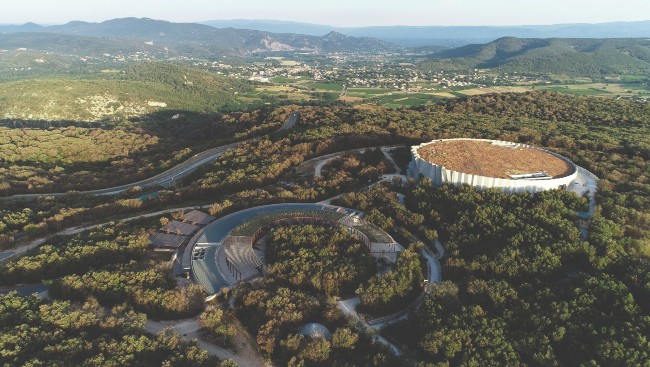
Chauvet 2, as seen from the sky. Photo: NEOS Films
Chauvet 2 is an open door into the era of our ancestors and an artistic sophistication previously unimaginable for primitive society. It is sure to delight visitors of all ages and levels of interest.
Open 365 days of the year, the Chauvet 2 experience is split into distinct parts, starting with the Aurignacian Gallery which puts the period and its people into perspective through lm reconstructions, touch-screen panels and some impressive life-size animals. Never stood next to a woolly mammoth? Well now’s your chance.
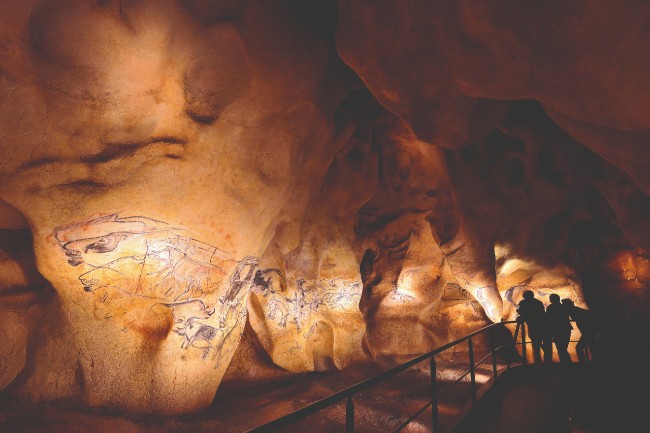
Chauvet 2 offers a fascinating insight into our past. Photo: M Dupont
Guided tours of the replica cavern are timed, the commentary relayed through headsets for the most intimate experience possible. Wind through this magical underworld, stopping to discover cave bear footprints and human handprints, as well as painted walls and intricate engravings.
Discover the latest temporary exhibition; enjoy the views from La Terrasse restaurant; and choose from a range of books and quality souvenirs in the shop. Adult admission, €9.60; children 10-17, €4.80; under- 10s, free.
From France Today magazine
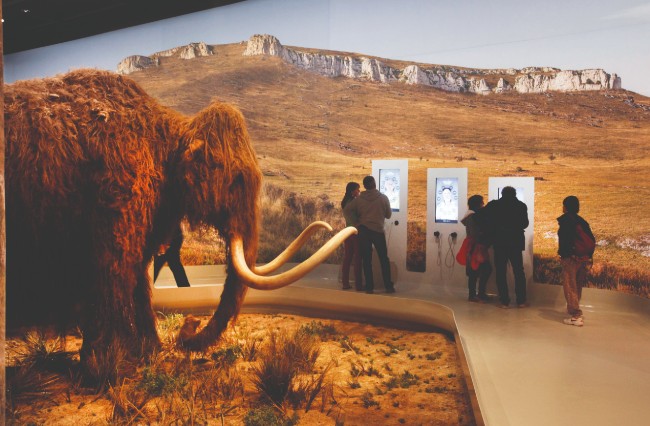
The Aurignacian Gallery puts the period and its people into perspective. Photo: P Aventurier/ Grotte Chauvet 2
Share to: Facebook Twitter LinkedIn Email
Leave a reply
Your email address will not be published. Required fields are marked *



